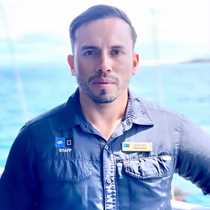Isabela Island (Urbina Bay & Tagus Cove)
We anchored off the central coast of Isabela, the largest of the Galápagos Islands. After a wet landing on a sandy beach, we went on an expedition to explore the arid zone of Galápagos. During the hike, many land iguanas were seen in their natural habitat, some of them in their nesting grounds. A juvenile giant tortoise was also spotted amidst the vegetation. We had the chance to do some bird watching for endemic Darwin finches in the incense tree forest.
Urbina Bay is an incredible place. In 1954 over one-and-a half square kilometers were uplifted — the ocean floor rose above sea level in a matter of minutes. After a hike among uplifted coral heads and yellow reptiles, we went for an excellent swim off the beach and then continued the morning with some Zodiac driving lessons for our younger explorers. Before lunch we had time to learn about the human history of the enchanted islands, where we learnt about the first settlements and got more interested in following Darwin’s footprints in this archipelago.
The afternoon activity led us to explore the underwater world of the Galápagos, with a snorkeling outing in a beautiful and well-protected Tagus Cove. We swam with sea turtles, rays and some of us were very lucky to even swim with penguins and grazing marine iguanas. Kayaking was another option; paddling along the coast of Isabela is simply outstanding. The amazing part of this kayaking outing is to be surrounded by the different geological features, and special designs shown by the eroded tuff cones among the cliffs. The Galápagos flightless cormorants are found in this very productive area of the enchanted archipelago, and we found several of them nesting on the lava rocks above the tidal line.
We finished our day with a hike, going all the way to the top of Darwin’s Lagoon, a place like no other with a great landscape and unique flora and many endemic Darwin finches.



